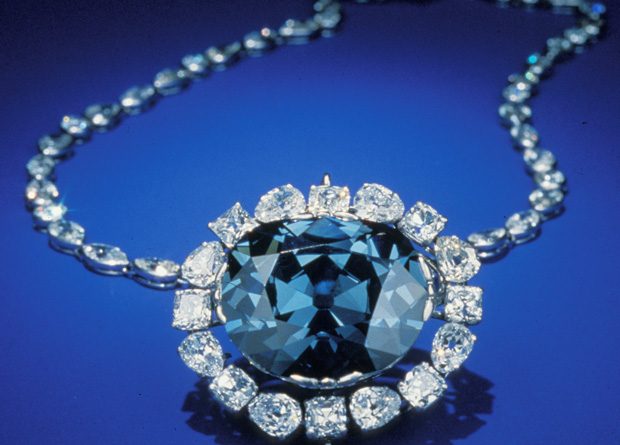The Cursed Diamond (Hope Diamond)
Source: http://en.wikipedia.org/wiki/Hope_Diamond
According to the legend, a curse befell the large, blue diamond when it was plucked (i.e. stolen) from an idol in India – a curse that foretold bad luck and death not only for the owner of the diamond but for all who touched it.
Whether or not you believe in the curse, the Hope diamond has intrigued people for centuries. Its perfect quality, its large size, and its rare color make it strikingly unique and beautiful. Add to this a varied history which includes being owned by King Louis XIV, stolen during the French Revolution, sold to earn money for gambling, worn to raise money for charity, and then finally donated to the Smithsonian Institution. The Hope diamond is truly unique.
Is there really a curse? Where has the Hope diamond been? Why was such a valuable gem donated to the Smithsonian?
The Hope Diamond, also known as “Le bleu de France” or “Le Bijou du Roi”, is a large, 45.52 carats (9.10 g), deep-blue diamond, now housed in the Smithsonian Natural History Museum in Washington, D.C. It is blue to the naked eye because of trace amounts of boron within its crystal structure, but exhibits red phosphorescence after exposure to ultraviolet light. It is classified as a Type IIb diamond, and is notorious for supposedly being cursed, and it has a long recorded history with few gaps in which it changed hands numerous times on its way from India to France to England and to the United States. It has been described as the “most famous diamond in the world” and, after the Mona Lisa, it is the second most-visited artwork in the world.
Taken from the Forehead of an Idol
The legend is said to begin with a theft. Several centuries ago, a man named Tavernier made a trip to India. While there, he stole a large blue diamond from the forehead (or eye) of a statue of the Hindu goddess Sita. For this transgression, according to the legend, Tavernier was torn apart by wild dogs on a trip to Russia (after he had sold the diamond). This was the first horrible death attributed to the curse.
How much of this is true? In 1642 a man by the name of Jean Baptiste Tavernier, a French jeweler who traveled extensively, visited India and bought a 112 3/16 carat blue diamond. (This diamond was much larger than the present weight of the Hope diamond because the Hope has been cut down at least twice in the past three centuries.) The diamond is believed to have come from the Kollur mine in Golconda, India.
Tavernier continued to travel and arrived back in France in 1668, twenty-six years after he bought the large, blue diamond. French King Louis XIV, the “Sun King,” ordered Tavernier presented at court. From Tavernier, Louis XIV bought the large, blue diamond as well as forty-four large diamonds and 1,122 smaller diamonds. Tavernier was made a noble and died at he age 84 in Russia (it is not known how he died).
According to Susanne Patch, author of Blue Mystery: The Story of the Hope Diamond, the shape of the diamond was unlikely to have been an eye (or on the forehead) of an idol
In 1673, King Louis XIV decided to re-cut the diamond to enhance its brilliance (the previous cut had been to enhance size and not brilliance). The newly cut gem was 67 1/8 carats. Louis XIV officially named it the “Blue Diamond of the Crown” and would often wear the diamond on a long ribbon around his neck.
In 1749, Louis XIV’s great-grandson, Louis XV, was king and ordered the crown jeweler to make a decoration for the Order of the Golden Fleece, using the blue diamond and the Cote de Bretagne (a large red spinel thought at the time to be a ruby).3 The resulting decoration was extremely ornate and large.
Stolen!
When Louis XV died, his grandson, Louis XVI, became king with Marie Antoinette as his queen. According to the legend, Marie Antoinette and Louis XVI were beheaded during the French Revolution because of the blue diamond’s curse.
Considering that King Louis XIV and King Louis XV had both owned and worn the blue diamond a number of times and have not been set down in legend as tormented by the curse, it is difficult to say that all those who owned or touched the gem would suffer an ill fate. Though it is true that Marie Antoinette and Louis XVI were beheaded, it seems that it had much more to do with their extravagance and the French Revolution than a curse on the diamond. Plus, these two royals were certainly not the only ones beheaded during the Reign of Terror.
During the French Revolution, the crown jewels (including the blue diamond) were taken from the royal couple after they attempted to flee France in 1791. The jewels were placed in the Garde-Meuble but were not well guarded.
From September 12 to September 16, 1791, the Garde-Meuble was repeatedly robbed, without notice from officials until September 17. Though most of the crown jewels were soon recovered, the blue diamond was not.
Why is it called the “Hope diamond”?
There is some evidence that the blue diamond resurfaced in London by 1813 and was owned by a jeweler Daniel Eliason by 1823.4 No one is sure that the blue diamond in London was the same one stolen from the Garde-Meuble because the one in London was of a different cut. Yet, most people feel the rarity and perfectness of the French blue diamond and the blue diamond that appeared in London makes it likely that someone re-cut the French blue diamond in the hopes of hiding its origin. The blue diamond that surfaced in London was estimated at 44 carats.
There is some evidence that shows King George IV of England bought the blue diamond from Daniel Eliason and upon King George’s death, the diamond was sold to pay off debts.
By 1939, possibly earlier, the blue diamond was in the possession of Henry Philip Hope, from whom the Hope diamond has taken its name.
The diamond has been surrounded by a mythology of a reputed curse to the effect that it brings misfortune and tragedy to persons who own it or wear it, but there are strong indications that such stories were not grounded in solid fact and were likely to have been fabricated to enhance the stone’s mystery and appeal, since increased publicity usually raised the gem’s value and newsworthiness.
According to specious accounts in the late nineteenth and early twentieth century, the original form of the Hope Diamond was stolen from an eye of a sculpted statue of the goddess Sita, the wife of Rama, the seventh Avatar of Vishnu. However, much like the “curse of Tutankhamun”, this general type of “legend” was most likely the invention of Western authors during the Victorian era, and the specific legends about the Hope Diamond’s “cursed origin” were invented in the early 20th century to add mystique to the stone and increase its sales appeal as well as increase newspaper sales. It fueled speculation that humans possessing the gemstone were fated to have bad luck with varying reports of undetermined veracity. A report in 2006 in The New York Times, however, suggested that “any hard evidence linking it to tragedy has yet to be officially proven.”
There is evidence of several newspaper accounts which helped spread the curse story. A New Zealand newspaper article in 1888 described the supposedly lurid history of the Hope Diamond, including a claim that it was “said once to have formed the single eye of a great idol”, as part of a confused description that also claimed that its namesake owner had personally “brought it from India”, and that the diamond’s true color was “white, [although] when held to the light, it emits the most superb and dazzling blue rays.” An article entitled “Hope Diamond Has Brought Trouble To All Who Have Owned It” appeared in the Washington Post in 1908.[56] An additional account of the Hope Diamond’s “cursed origins” was a fanciful and anonymously written newspaper article in 1909. It was followed by another article in 1911 which detailed a rather lengthy list of supposed cases of ill-fortune but with few confirmations from other sources:
* Jacques Colet bought the Hope Diamond from Simon Frankel and committed suicide.
* Prince Ivan Kanitovski bought it from Colet but was killed by Russian revolutionists.
* Kanitovski loaned it to Mlle Ladue who was “murdered by her sweetheart.”
* Simon Mencharides, who had once sold it to the Turkish sultan, was thrown from a precipice along with his wife and young child
* Sultan Hamid gave it to Abu Sabir to “polish” but later Sabir was imprisoned and tortured.
* Stone guardian Kulub Bey was hanged by a mob in Turkey.
* A Turkish attendant named Hehver Agha was hanged for having it in his possession.
* Tavernier, who brought the stone from India to Paris was “torn to pieces by wild dogs in Constantinople.”
* King Louis gave it to Madama de Montespan whom later he abandoned.
* Nicholas Fouquet, an “Intendant of France”, borrowed it temporarily to wear it but was “disgraced and died in prison.”
* A temporary wearer, Princess de Lamballe, was “torn to pieces by a French mob.”
* Jeweler William Fals who recut the stone “died a ruined man.”
* William Fals’ son Hendrik stole the jewel from his father and later committed suicide.”
* Some years (after Hendrik) “it was sold to Francis Deaulieu, who died in misery and want.”
Source: The New York Times, January 29, 1911
The mainstream academic view is that these accounts are specious and speculative since there are few, if any, independent confirmations or historical scholarship to back them up. A few months later, perhaps compounded by inaccurate reports in The New York Times on November 17, 1909, it was incorrectly reported that the diamond’s former owner, Selim Habib, had drowned in a shipwreck of the steamer Seyne near Singapore; in fact, it was a different person with the same name, not the owner of the diamond. There was speculation that jeweler Pierre Cartier further embroidered the lurid tales to intrigue Evalyn Walsh McLean into buying the Hope Diamond in 1911.
The theme of greedy robbers stealing a valuable metal from the tomb or shrine of an ancient god or ruler, and then being punished by it, is one which repeats in many different forms of literature. A likely source of inspiration for the fabrications was the Wilkie Collins’ 1868 novel The Moonstone, which created a coherent narrative from vague and largely disregarded legends which had been attached to other diamonds such as the Koh-i-Noor and the Orloff diamond. The theme can be seen in films such as The Mummy as well as stories about the curse of Egyptian king Tutankhamun and in more recent films such as the Indiana Jones films. In keeping with these scripts, according to the legend, Tavernier did not buy the Hope diamond but stole it from a Hindu temple where it had been set as one of two matching eyes of an idol, and the temple priests then laid a curse on whoever might possess the missing stone. Largely because the other blue diamond “eye” never surfaced, historians dismissed the fantastical story.[citation needed] The stories generally do not bear up to more pointed examination; for example, the legend that Tavernier’s body was “torn apart by wolves” is inconsistent with historical evidence which shows that he lived to 84 and died of natural causes.
It is possible that the overblown story of the curse, possibly fueled by Cartier and others, may have caused some hesitation on the part of the prospective buyers, the McLeans, around 1911. When a lawsuit between buyer and seller erupted about the terms of the deal, newspapers kept alive reports of the diamond’s “malevolent influence” with reports blaming like this one, which blamed the stone’s “curse” on having caused, of all things, the lawsuit itself:
The malevolent influence that has for centuries dogged with discord and disaster the owners of the famous Hope diamond has started again and without waste of time, despite special precautions against ill-luck taken at the time of its last sale, according to John S. Wise, Jr., of 20 Broad Street, attorney for Cartiers, the Fifth Avenue jewelers, who are suing Mr. and Mrs. Edward B. McLean for $180,000, its alleged purchase price.
report in The New York Times, March 1911
The Hope Diamond was also blamed for the unhappy fates of other historical figures vaguely linked to its ownership, such as the falls of Madame Athenais de Montespan and French finance minister Nicolas Fouquet during the reign of Louis XIV of France; the beheadings of Louis XVI and Marie Antoinette and the rape and mutilation of the Princesse de Lamballe during the French Revolution; and the forced abdication of Turkish Sultan Abdul Hamid who had supposedly killed various members of his court for the stone (despite the annotation in Habib’s auction catalog). Even jewelers who may have handled the Hope Diamond were not spared from its reputed malice: the insanity and suicide of Jacques Colot, who supposedly bought it from Eliason, and the financial ruin of the jeweler Simon Frankel, who bought it from the Hope family, were linked to the stone.[11] But although he is documented as a French diamond dealer of the correct era, Colot has no recorded connection with the stone, and Frankel’s misfortunes were in the midst of economic straits that also ruined many of his peers. The legend includes deaths of numerous other characters who had been previously unknown: Diamond cutter Wilhelm Fals, killed by his son Hendrik, who stole it and later committed suicide; Francois Beaulieu, who received the stone from Hendrik but starved to death after selling it to Daniel Eliason; a Russian prince named Kanitowski, who lent it to French actress Lorens Ladue and promptly shot her dead on the stage, and was himself stabbed to death by revolutionaries; Simon Montharides, hurled over a precipice with his family.[11] However, the existence of only a few of these characters has been verified historically, leading researchers to conclude that most of these persons are fictitious.
The actress May Yohe made repeated attempts to capitalize on her identity as the former wife of the last Hope to own the diamond, and sometimes blamed the gemstone for her misfortunes. In July 1902, months after Lord Francis divorced her, she told police in Australia that her lover, Putnam Strong, had abandoned her and taken her jewels. In fact, the couple reconciled, married later that year, but divorced in 1910. On her third marriage in 1920, she persuaded film producer George Kleine to back a 15-episode serial The Hope Diamond Mystery, which added fictitious characters to the tale, but the project was not successful. In 1921, she hired Henry Leyford Gates to help her write The Mystery of the Hope Diamond, in which she starred as Lady Francis Hope. The film added more characters, including a fictionalized Tavernier, and added Marat among the diamond’s “victims”. She also wore her copy of the Hope, trying to generate more publicity to further her career.
Evalyn Walsh McLean added her own narrative to the story behind the blue jewel, including that one of the owners had been Catherine the Great, although there are no confirmations that the Russian ruler ever owned the diamond. McLean would bring the Diamond out for friends to try on, including Warren G. Harding and Florence Harding.
Since the Smithsonian acquired the gemstone, the “curse appears to have gone dormant.” Owning the diamond has brought “nothing but good luck” for the nonprofit national museum, according to a Smithsonian curator, and has helped it build a “world-class gem collection” with rising attendance levels.
// ]]>



